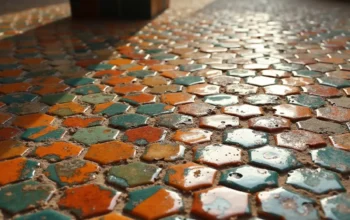
Choosing the right flooring material is a crucial decision that impacts both aesthetics and functionality. Stone and ceramic tiles are popular flooring choices, each with unique pros and cons. Knowing their differences in durability, maintenance, and cost helps you decide wisely.
Both stone and ceramic tiles have unique qualities that suit different preferences and lifestyles. In this guide, we will compare these flooring options based on several factors to determine which one is better suited for your home.
Contents
Durability and Longevity
Stone tiles are known for their incredible durability and long lifespan. Natural stone, such as granite and slate, is highly resistant to wear and can last for decades when properly maintained. However, softer stones like marble and limestone may be more susceptible to scratches and stains.
Ceramic tiles, on the other hand, are also durable but can be more prone to chipping and cracking under heavy impact. While high-quality ceramic tiles can withstand daily wear, they may not last as long as certain types of natural stone. If longevity is a priority, stone flooring may be the better option.
Aesthetic Appeal
Stone tiles offer a timeless and luxurious appearance that enhances the beauty of any space. Each natural stone tile has unique patterns and textures, creating a distinctive look that adds character to a room. Stone flooring works well in both modern and traditional interiors.
Ceramic tiles come in a vast range of designs, colors, and patterns, making them highly versatile. Advances in tile manufacturing allow ceramic tiles to mimic the appearance of stone, wood, and other materials. If you prefer a more customizable look, ceramic tiles may offer more design flexibility.
Maintenance and Cleaning
Stone tiles require more maintenance compared to ceramic tiles. Since natural stone is porous, it needs to be sealed periodically to prevent moisture absorption and staining. Regular cleaning with a stone-friendly cleaner is essential to maintain its pristine appearance.
Ceramic tiles are much easier to maintain due to their non-porous surface. They do not require sealing and can be cleaned with standard household cleaners. If low maintenance is a top priority, ceramic tiles may be the better choice.
Cost Considerations
The cost of stone tile flooring can be significantly higher than ceramic tiles. Natural stone is often more expensive due to extraction, transportation, and installation costs. Additionally, professional installation is recommended for stone tiles, which can further increase expenses.
Ceramic tiles are generally more affordable and offer budget-friendly options for homeowners. With a wide variety of price points, ceramic tiles provide a cost-effective way to achieve stylish flooring without breaking the bank. If you have a limited budget, ceramic tiles may be the more practical option.
Comfort and Feel
Stone tiles tend to feel harder and colder underfoot, which may not be ideal for bedrooms or living spaces. However, they work well in warm climates, as they help keep rooms cooler. Radiant heating can be installed underneath stone tiles to improve comfort in colder regions.
Ceramic tiles are also hard underfoot but tend to be slightly more comfortable due to their smoother surface. They can also feel cold in winter, but they are compatible with underfloor heating systems. If comfort is a concern, consider adding rugs or using heating solutions to enhance warmth.
Environmental Impact
Natural stone is an environmentally friendly flooring option, as it is sourced directly from the earth without excessive chemical processing. However, quarrying and transporting stone can have a higher carbon footprint compared to ceramic tiles.
Ceramic tiles are made from natural clay but require firing at high temperatures, which consumes energy. Some manufacturers offer eco-friendly ceramic tiles made with recycled materials. If sustainability is a priority, researching the sourcing and production methods of each material is recommended.
Conclusion
Both stone and ceramic tile flooring have their advantages and are suited to different needs and preferences. Stone offers unmatched durability, a natural aesthetic, and a long lifespan, while ceramic tiles provide affordability, low maintenance, and design versatility.
Ultimately, the best choice depends on your budget, lifestyle, and design vision. Whether you opt for the timeless appeal of stone or the practicality of ceramic, selecting the right flooring will enhance the beauty and functionality of your home.



